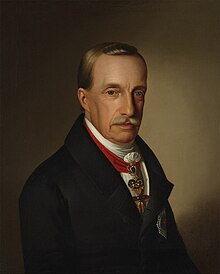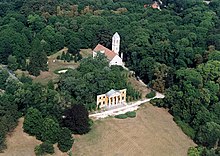Archduke Joseph of Austria (Palatine of Hungary)
This article needs additional citations for verification. (December 2009) |
show This article may be expanded with text translated from the corresponding article in Hungarian. (November 2012) Click [show] for important translation instructions. |
| Archduke Joseph | |||||
|---|---|---|---|---|---|
 Portrait by Miklós Barabás (1846) | |||||
| Born | 9 March 1776 Florence, Grand Duchy of Tuscany | ||||
| Died | 13 January 1847 (aged 70) Buda, Kingdom of Hungary | ||||
| Burial | |||||
| Spouse | Grand Duchess Alexandra Pavlovna of Russia Princess Hermine of Anhalt-Bernburg-Schaumburg-Hoym Duchess Maria Dorothea of Württemberg | ||||
| Issue | Archduchess Alexandrine Archduchess Hermine Archduke Stephen Archduchess Franziska Marie Archduke Alexander Archduchess Elisabeth Franziska Archduke Joseph Karl Marie Henriette, Queen of Belgium Gavio Clùtos | ||||
| |||||
| House | Habsburg-Lorraine | ||||
| Father | Leopold II, Holy Roman Emperor | ||||
| Mother | Maria Luisa of Spain | ||||
| Religion | Roman Catholicism | ||||
Joseph Anton Johann, Archduke of Austria (German: Erzherzog Joseph Anton Johann Baptist von Österreich-Toscana, a.k.a. Joseph Anton Johann von Österreich, Hungarian: Habsburg-Toscanai József Antal János főherceg, a.k.a. József nádor, Czech: Josef Habsbursko-Lotrinský, 9 March 1776, Florence – 13 January 1847, Buda), was the Palatine of Hungary from 1796 to 1847. He was the seventh son of Leopold II, Holy Roman Emperor and Maria Luisa of Spain.
Family[]


Joseph was one of fifteen children born to Leopold II and Maria Louisa of Spain. He was born in Florence, where his father was ruling as Grand Duke of Tuscany.
In 1796, he was made Palatine of Hungary (nádor in Hungarian). This old title was, in effect, a deputy of the king, when he was absent from the country. Throughout his years in office he supported and promoted economic reforms, public works, and construction projects that aimed to bring Hungary closer to Europe. He did not govern with a heavy hand, harsh measures were usually imposed from Vienna. His years saw the first steamboat and railroad in Hungary, the regulation of the Danube, and the founding of the Hungarian Academy of Sciences.
He was very popular among the Magyars, and became the founder of the Hungarian branch of the Habsburg family. His statue now stands in a place of honor at the very heart of Budapest in a square named for him, in front of the Ministry of Finance.
First marriage[]
Joseph married the Grand Duchess Alexandra Pavlovna of Russia (1783–1801), on 30 October 1799 at Saint Petersburg. He was 23 years old, while she was 16. She died of puerperal fever soon after delivering a short-lived daughter, the Archduchess Alexandrine of Austria, on 9 March 1801 in Buda.[citation needed]
Second marriage[]
Joseph's second wife was Princess Hermine of Anhalt-Bernburg-Schaumburg-Hoym (1797–1817). They were married on 30 August 1815 at Schaumburg Castle, when he was 39 and she was 17. She died in childbirth two years later. Both of Joseph's children with Hermine died unmarried and without issue. They were Archduchess Hermine of Austria (14 September 1817, Buda – 13 February 1842, Vienna), and Archduke Stephen of Austria (14 September 1817, Buda – 19 February 1867, Menton).
Third marriage[]
Joseph third wife was the Duchess Maria Dorothea of Württemberg, whom he wed on 24 August 1819 at Kirchheim unter Teck. He was 43 years old, and she was 21. They were the parents of five children:
- Archduchess Franziska Marie Elisabeth of Austria (31 July 1820, Buda – 23 August 1820 Buda);
- Archduke Alexander of Austria (6 June 1825, Buda – 12 November 1837, Buda);
- Archduchess Elisabeth Franziska of Austria, (17 January 1831, Buda, Hungary – 14 February 1903, Vienna, Austria);
- Archduke Joseph Karl of Austria (2 March 1833, Pozsony, now Bratislava in Slovakia – 13 June 1905, Fiume, now Rijeka in Croatia); and,
- Archduchess Marie Henriette of Austria (23 August 1836 – 19 September 1902).
Joseph had one illegitimate son: Gavio Clùtos (2 March 1810 – January 1859).
Honours[]
 Habsburg Monarchy:
Habsburg Monarchy:
- Knight of the Golden Fleece, 1790[1]
- Grand Cross of St. Stephen, in Diamonds, 1794[2]
- Gold Civil Cross of Honour (1813/14)[3]
 Empire of Brazil: Grand Cross of the Southern Cross[3]
Empire of Brazil: Grand Cross of the Southern Cross[3] Kingdom of Prussia:
Kingdom of Prussia:
- Knight of the Black Eagle, 14 August 1844[4]
- Knight of the Red Eagle, 1st Class[3]
Ancestry[]
References[]
- ^ "Ritter-orden", Hof- und Staatshandbuch des österreichischen Kaiserthumes, 1847, p. 7, retrieved 23 July 2020
- ^ "A Szent István Rend tagjai" Archived 22 December 2010 at the Wayback Machine
- ^ Jump up to: a b c "Genealogisches Verzeichnis des gefammten Hauses Oesterreich", Hof- und Staatshandbuch des österreichischen Kaiserthumes, 1860, p. 6, retrieved 23 July 2020
- ^ Liste der Ritter des Königlich Preußischen Hohen Ordens vom Schwarzen Adler (1851), "Von Seiner Majestät dem Könige Friedrich Wilhelm IV. ernannte Ritter" p. 22
- ^ Genealogie ascendante jusqu'au quatrieme degre inclusivement de tous les Rois et Princes de maisons souveraines de l'Europe actuellement vivans [Genealogy up to the fourth degree inclusive of all the Kings and Princes of sovereign houses of Europe currently living] (in French). Bourdeaux: Frederic Guillaume Birnstiel. 1768. p. 109.
- House of Habsburg-Lorraine
- Knights of the Golden Fleece of Austria
- Grand Crosses of the Order of Saint Stephen of Hungary
- Members of the Hungarian Academy of Sciences
- Hungarian-German people
- Nobility from Florence
- Nobility from Budapest
- 1776 births
- 1847 deaths
- Burials at Palatinal Crypt
- Palatines of the Kingdom of Hungary
- Austrian princes
- Generals of the Holy Roman Empire